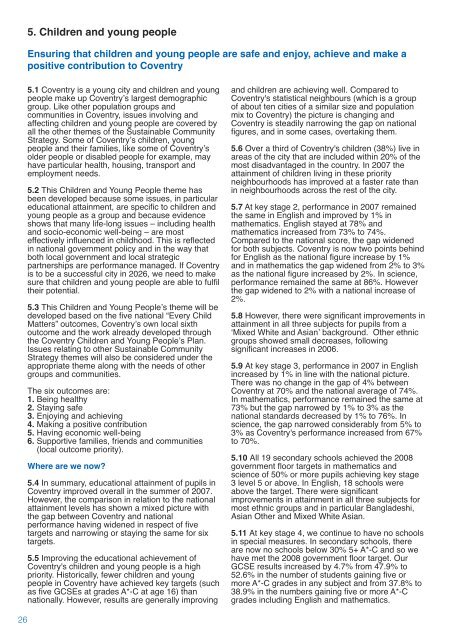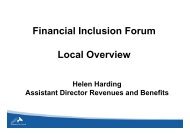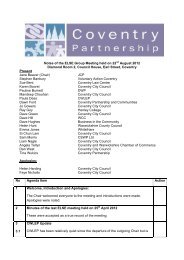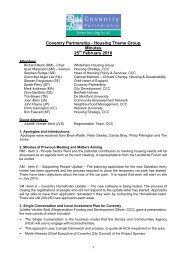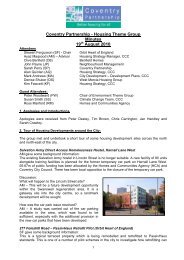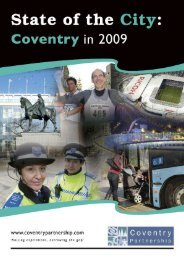Sustainable Community Strategy - Coventry Partnership
Sustainable Community Strategy - Coventry Partnership
Sustainable Community Strategy - Coventry Partnership
Create successful ePaper yourself
Turn your PDF publications into a flip-book with our unique Google optimized e-Paper software.
5. Children and young people<br />
Ensuring that children and young people are safe and enjoy, achieve and make a<br />
positive contribution to <strong>Coventry</strong><br />
5.1 <strong>Coventry</strong> is a young city and children and young<br />
people make up <strong>Coventry</strong>ʼs largest demographic<br />
group. Like other population groups and<br />
communities in <strong>Coventry</strong>, issues involving and<br />
affecting children and young people are covered by<br />
all the other themes of the <strong>Sustainable</strong> <strong>Community</strong><br />
<strong>Strategy</strong>. Some of <strong>Coventry</strong>ʼs children, young<br />
people and their families, like some of <strong>Coventry</strong>ʼs<br />
older people or disabled people for example, may<br />
have particular health, housing, transport and<br />
employment needs.<br />
5.2 This Children and Young People theme has<br />
been developed because some issues, in particular<br />
educational attainment, are specific to children and<br />
young people as a group and because evidence<br />
shows that many life-long issues – including health<br />
and socio-economic well-being – are most<br />
effectively influenced in childhood. This is reflected<br />
in national government policy and in the way that<br />
both local government and local strategic<br />
partnerships are performance managed. If <strong>Coventry</strong><br />
is to be a successful city in 2026, we need to make<br />
sure that children and young people are able to fulfil<br />
their potential.<br />
5.3 This Children and Young Peopleʼs theme will be<br />
developed based on the five national “Every Child<br />
Matters” outcomes, <strong>Coventry</strong>ʼs own local sixth<br />
outcome and the work already developed through<br />
the <strong>Coventry</strong> Children and Young Peopleʼs Plan.<br />
Issues relating to other <strong>Sustainable</strong> <strong>Community</strong><br />
<strong>Strategy</strong> themes will also be considered under the<br />
appropriate theme along with the needs of other<br />
groups and communities.<br />
The six outcomes are:<br />
1. Being healthy<br />
2. Staying safe<br />
3. Enjoying and achieving<br />
4. Making a positive contribution<br />
5. Having economic well-being<br />
6. Supportive families, friends and communities<br />
(local outcome priority).<br />
Where are we now?<br />
5.4 In summary, educational attainment of pupils in<br />
<strong>Coventry</strong> improved overall in the summer of 2007.<br />
However, the comparison in relation to the national<br />
attainment levels has shown a mixed picture with<br />
the gap between <strong>Coventry</strong> and national<br />
performance having widened in respect of five<br />
targets and narrowing or staying the same for six<br />
targets.<br />
5.5 Improving the educational achievement of<br />
<strong>Coventry</strong>'s children and young people is a high<br />
priority. Historically, fewer children and young<br />
people in <strong>Coventry</strong> have achieved key targets (such<br />
as five GCSEs at grades A*-C at age 16) than<br />
nationally. However, results are generally improving<br />
and children are achieving well. Compared to<br />
<strong>Coventry</strong>'s statistical neighbours (which is a group<br />
of about ten cities of a similar size and population<br />
mix to <strong>Coventry</strong>) the picture is changing and<br />
<strong>Coventry</strong> is steadily narrowing the gap on national<br />
figures, and in some cases, overtaking them.<br />
5.6 Over a third of <strong>Coventry</strong>'s children (38%) live in<br />
areas of the city that are included within 20% of the<br />
most disadvantaged in the country. In 2007 the<br />
attainment of children living in these priority<br />
neighbourhoods has improved at a faster rate than<br />
in neighbourhoods across the rest of the city.<br />
5.7 At key stage 2, performance in 2007 remained<br />
the same in English and improved by 1% in<br />
mathematics. English stayed at 78% and<br />
mathematics increased from 73% to 74%.<br />
Compared to the national score, the gap widened<br />
for both subjects. <strong>Coventry</strong> is now two points behind<br />
for English as the national figure increase by 1%<br />
and in mathematics the gap widened from 2% to 3%<br />
as the national figure increased by 2%. In science,<br />
performance remained the same at 86%. However<br />
the gap widened to 2% with a national increase of<br />
2%.<br />
5.8 However, there were significant improvements in<br />
attainment in all three subjects for pupils from a<br />
ʻMixed White and Asianʼ background. Other ethnic<br />
groups showed small decreases, following<br />
significant increases in 2006.<br />
5.9 At key stage 3, performance in 2007 in English<br />
increased by 1% in line with the national picture.<br />
There was no change in the gap of 4% between<br />
<strong>Coventry</strong> at 70% and the national average of 74%.<br />
In mathematics, performance remained the same at<br />
73% but the gap narrowed by 1% to 3% as the<br />
national standards decreased by 1% to 76%. In<br />
science, the gap narrowed considerably from 5% to<br />
3% as <strong>Coventry</strong>'s performance increased from 67%<br />
to 70%.<br />
5.10 All 19 secondary schools achieved the 2008<br />
government floor targets in mathematics and<br />
science of 50% or more pupils achieving key stage<br />
3 level 5 or above. In English, 18 schools were<br />
above the target. There were significant<br />
improvements in attainment in all three subjects for<br />
most ethnic groups and in particular Bangladeshi,<br />
Asian Other and Mixed White Asian.<br />
5.11 At key stage 4, we continue to have no schools<br />
in special measures. In secondary schools, there<br />
are now no schools below 30% 5+ A*-C and so we<br />
have met the 2008 government floor target. Our<br />
GCSE results increased by 4.7% from 47.9% to<br />
52.6% in the number of students gaining five or<br />
more A*-C grades in any subject and from 37.8% to<br />
38.9% in the numbers gaining five or more A*-C<br />
grades including English and mathematics.<br />
26


